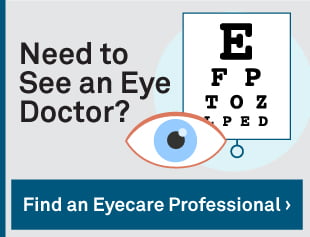Astigmatism is a common eye condition that occurs in both nearsighted and farsighted individuals. Read more about the symptoms and treatments below:
Symptoms
Caused by an irregular-shaped cornea, most people have at least a small degree of astigmatism, but those with a larger degree will have blurred vision, headaches, and discomfort in the eye.
Treatment
Many people with astigmatism have it to such a small degree that no corrective measures need to be taken. In cases where compensation is needed, the condition can usually be treated with eyeglasses or contact lenses for astigmatism.
Some people choose to correct their astigmatism with rigid contact lenses, but in recent years the popular option is soft lenses called toric contact lenses. Many people believe toric contact lenses are the best contact lenses for astigmatism because they can treat nearsightedness or farsightedness and also have astigmatism correction built in.
Surgeries for Astigmatism
Those with a high degree of astigmatism may consider correcting the condition with refractive surgery. There are many different procedures to choose from:
-Astigmatic Keratotomy
AK corrects astigmatism with two incisions at the steepest part of the football-shaped cornea, which allows the cornea to relax and naturally round out.
-Conductive Keratoplasty
Radio frequency energy, via a probe instead of a laser, is used to reduce the collagen in peripheral cornea, thus no incisions are made. It corrects nearsightedness and it’s effects on correcting astigmatism are being researched. The procedure takes about three minutes, and most people experience 20/20 vision or better for, at least, two years following.
-Customized Trans-Epithelial Non-Contact Ablation (C-Ten)
Benefitting those with myopia and irregular astigmatism, the C-Ten procedure, as the name implies, removes the regenerative surface of the eye with no direct contact. The postoperative side effects are nearly non-existent and this treatment is considered the fastest laser treatment available.
-Laser Assisted Intrastromal Keratomileusis (LASIK)
Used to correct nearsightedness, farsightedness, and astigmatism, LASIK procedures reshape the cornea by temporarily removing a flap of the cornea and applying laser energy to remove tissue. The flap is replaced, and the eye heals on its own.
-Limbal Relaxing Incisions (LRI)
Similar to AK, LRIs correct astigmatism by polar incisions, but instead of placing the incisions directly on the cornea, they are on the limbus, which is the point where the cornea meets the sclera. Because there is no incision made to the cornea, no weakness is inflicted and the cornea can reform itself into an even more spherical shape.
Resources on Astigmatism
- National Library of Medicine: Astigmatism: Causes, Symptoms, Tests, Treatment
- All About Eyes Astigmatism: What it Means, What to Do About It
- American Optometric Association: FAQ’s on Astigmatism
- Mayo Clinic’s Comprehensive Overview of Astigmatism
- WebMd: Astigmatism and your Eyes
- MedicineNet Astigmatism Symptoms and Correction
Resources on Surgery for Astigmatism
- WebMd: Astigmatic Keratotomy Eye Surgery
- University of California’s Study on Astigmatic Keratotomy
- FOCUS Eye Surgery: cTen Laser Correction
- USA Eyes cTen Q&A
- Society for Clinical Ophthalmology “Limbal relaxing incision for treatment of astigmatism”
- Cataract and Refractive Surgery Today Article: Limbal Relaxing Incisions
- FDA: What is LASIK?
- All About Eyes Complete LASIK Consumer Guide
- MedicineNet LASIK Surgery Risks
- ABC News: “What Is The Difference Between LASEK And LASIK, And Is One Procedure Better Than The Other For Vision Correction?”
- Conductive Keratoplasty reduces need for reading glasses
- About Conductive Keratoplasty





0 Comments